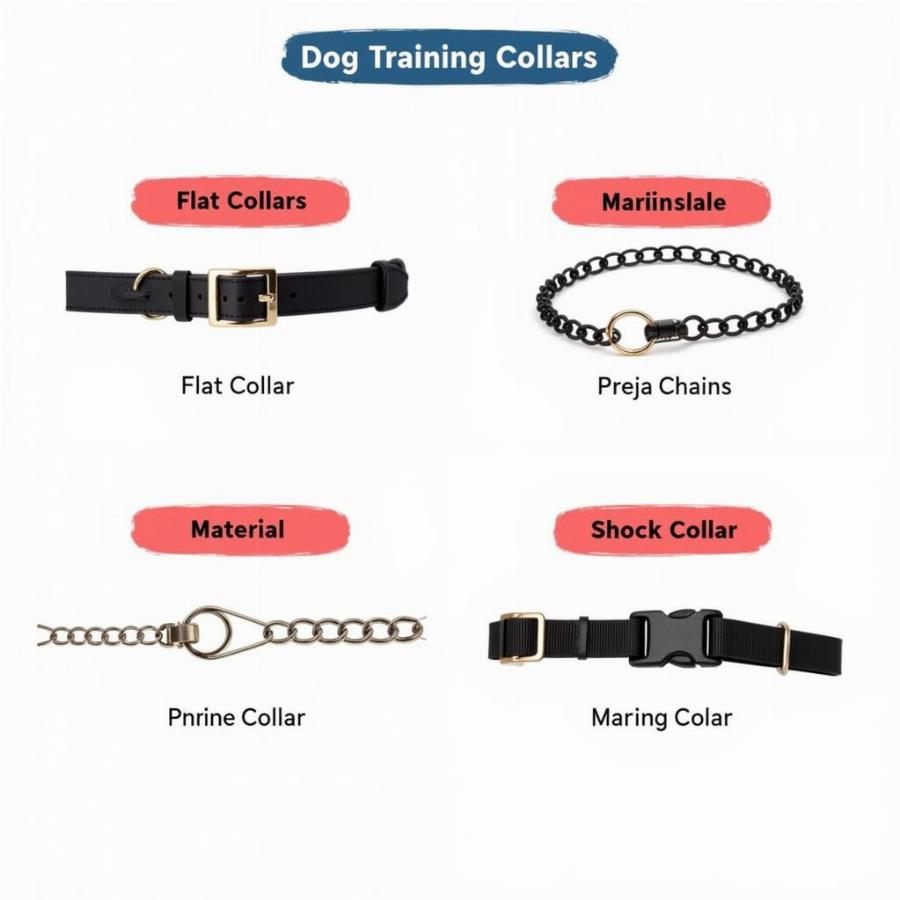Choosing the right dog training collar can be a game-changer in your journey towards a well-behaved and happy canine companion. With so many options available, finding the top rated dog training collars can feel overwhelming. This comprehensive guide will delve into the world of dog training collars, exploring different types, features, and helping you make an informed decision for your furry friend.
Types of Dog Training Collars
Dog training collars cater to different training styles and dog temperaments. Understanding the various types is crucial in selecting the most effective tool.
Flat Collars
Flat collars are the most basic type, typically made of nylon or leather. While not specifically designed for training, they are essential for identification tags and leash attachment. They’re great for everyday use and for dogs who don’t pull excessively on the leash.
Martingale Collars
Martingale collars, also known as limited-slip collars, are a humane alternative to choke chains. They tighten slightly when a dog pulls, preventing escape without choking. They are particularly useful for dogs with slender necks, like Greyhounds or Whippets.
Choke Chains/Slip Collars
These collars tighten around a dog’s neck when they pull. While they can be effective, they can also be harmful if used incorrectly. We advise caution and proper training from a certified dog trainer before using this type of collar.
Prong Collars/Pinch Collars
Prong collars have metal prongs that press against a dog’s neck when they pull. These collars should only be used under the guidance of a professional dog trainer due to the potential for misuse and injury.
Shock Collars/E-Collars
Shock collars deliver a static correction to a dog when they exhibit unwanted behaviors. They offer varying levels of intensity and can be used for remote training. However, their use is controversial and requires careful consideration and responsible handling.
 Top Rated Dog Training Collars: A Variety of Options
Top Rated Dog Training Collars: A Variety of Options
Choosing the Right Collar for Your Dog
Selecting the most appropriate dog training collar depends on various factors:
- Dog’s size and breed: A small dog requires a different collar size and style than a large breed.
- Temperament: A sensitive dog might respond better to a gentle training approach with a martingale collar, while a more stubborn dog might benefit from a different type.
- Training goals: Are you focusing on basic obedience, leash training, or addressing specific behavioral issues?
- Experience level: If you are a first-time dog owner, seeking guidance from a professional dog trainer is recommended before using certain collar types.
Features to Consider
When comparing top rated dog training collars, consider these features:
- Material: Durable and comfortable materials like nylon, leather, or biothane are ideal.
- Adjustability: A properly fitting collar is crucial for safety and effectiveness.
- Buckle or clasp: A secure and easy-to-use fastening mechanism is essential.
- Additional features: Some collars offer reflective strips for visibility, quick-release buckles for safety, or padded areas for added comfort.
Training Tips for Effective Collar Use
- Positive reinforcement: Always pair collar use with positive reinforcement methods like treats, praise, and toys.
- Consistency: Be consistent with your training commands and collar usage.
- Professional guidance: Consult a certified dog trainer for personalized advice and training techniques.
Frequently Asked Questions
- What is the best collar for a puppy? A lightweight, adjustable flat collar is usually suitable for puppies.
- Are shock collars humane? The use of shock collars is controversial. Consult a professional dog trainer before considering this type of collar.
- How do I fit a martingale collar correctly? A properly fitted martingale collar should be snug but allow you to fit two fingers comfortably between the collar and your dog’s neck.
Conclusion
Choosing from the top rated dog training collars requires careful consideration of your dog’s individual needs and your training goals. By understanding the various types, features, and training techniques, you can make an informed decision that promotes a positive and effective training experience for both you and your canine companion. Remember to prioritize your dog’s well-being and seek professional guidance when needed.